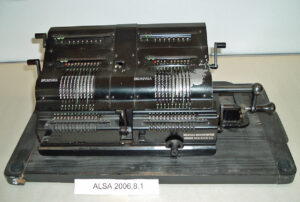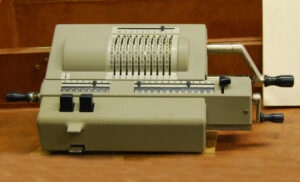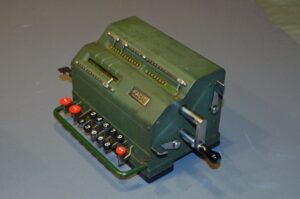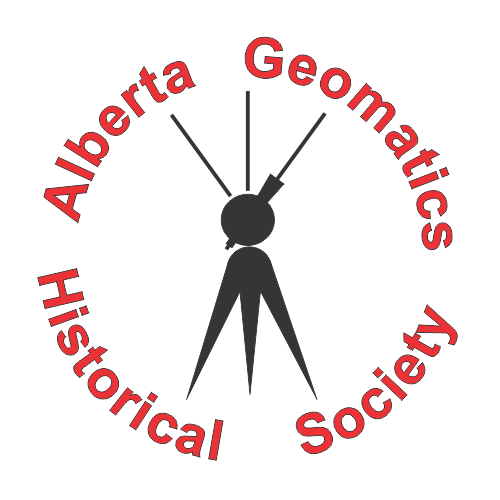
21. Too Cumbersome for the Field – Mechanical Calculators
By Gordon Olsson
The introduction of logarithms for calculations, followed by the invention of the slide rule, predated mechanical calculators. In 1642, Blaise Pascal is credited with designing one of the earliest forms of a calculating machine which could perform addition and subtraction. Its operation is somewhat similar to the Lightning Mechanical Calculator illustrated later in this article.
An early hand-cranked mechanical calculator was the Odhner. The history of Odhner calculators goes as far back as 1875 when Willgodt Odhner started producing calculators in Saint Petersburg, Russia. After the Russian revolution, the company was nationalized and moved to Moscow. Alexander, Willgodt’s son, who was managing the company before it was taken over, moved to Gothenburg in Sweden and built a new company Aktiebogalet Original-Odhner from scratch. Other companies and calculators were soon to follow. A German company, in 1892, began to make a clone of the Odnher calculator in Braunschweig using the brand name Brunsviga. Facit AB was a Swedish company founded in Stockholm, Sweden in 1918 that also made mechanical calculators based on the Odhner design.
The Curta was a major breakthrough for the field surveyor. It was invented by Curt Herzstark, an Austrian engineer. During WW2, Curt, who was half Jew, was arrested in 1943 for supporting Jews, state disintegration, and relationships with Aryan women. He was found guilty and in November 1943 was sent to the Buchenwald concentration camp. Because of Herzstark’s past experience, he was assigned to Gustloff-Werk, a mechanical factory in Weimar. There he was allowed to draw plans for his small calculating machine during evenings and weekends. After the war he was invited to establish a new factory in Liechtenstein for its production. Two types of Curtas were produced, type 1 with multiplier input to six significant digits and type 11 to eight significant digits. By 1972, an estimated 150,000 Curta calculators had been made.
By the early 1970s, with the advent of electronic calculators, the market for mechanical calculators collapsed. Hand-cranked mechanical calculators used with the US Department of Commerce book Natural Sines and Cosines to Eight Decimal Places – and Curta calculators with well-worn books of Chambers tables – would soon end up in storage rooms, be kept for posterity or end up in museums.

Brunsviga Calculator. Also included with it is a cover for the calculator and a manual (in German). The full name for this calculator is Brunsviga-Rechmaschine Doppel 13Z. Rechmaschine Doppel translated from German to English is “Double Calculator” meaning it can preform two calculations at the same time. The model number is 13Z which was made from 1934 to 1947. The number 13 refers to the number of digits that could be entered at the bottom of the calculator. The letter Z refers to “Zehner” which translated from German to English is “tens” which refers to tens in the revolutions counter. It was ideal for calculating coordinates. The trigonometric functions are put in at the bottom of the calculator – the sine of the bearing on one side and the cosine on the other. The large crank on the right side is used to put in the distance which concurrently multiplies both the sine and cosine functions giving the x and y coordinates. Siegfried Osterwoldt bought it in 1954 from a lecturer at the Hamburg Institute of Technology who had bought it new in 1947. Siegfried paid 750 marks for it, which was about one and a half months salary at the time. He brought it with him when he immigrated to Canada in 1954 and used it in Canada for survey calculations. For more about Siegfried see Article 13, Kern – 170 Years of History and ALS News, Winter Edition 1982.
Donated by Siegfried Osterwoldt
ALSA 2006.08.01

Odhner Calculator. It is labelled “Aktiebogalet Original-Odhner” s/n 39-289679 where 39 is the model number. Model number 39 was produced from 1939 to 1950. This calculator was owned by Ted Rippon. Ted was president of the ALSA in 1966 and surveyor to the Land Titles office from 1957 to 1976. He was made an honorary life member in 1988. Donated by Ted Rippon, ALS #195.
ALSA 2006.17.01

A later model Odhner Calculator. It has s/n 227-828632” marked on the bottom of the calculator. It comes with a case and a manual. The Odhner was restyled twice: in 1948 and in 1955. 100 was added to model numbers of the 1948 restyling and another 100 was added to model numbers of the 1955 restyling. The 1955 restyling was done by Sigvard Bernadotte who was a member of the Swedish Royal Family and a successful industrial designer. This Odhner, model “227,” was produced from 1955 to 1969. It was used by Murray Ingalls for surveys in Alberta.
Donated by Murray Ingalls ALS #275.
ALSA 2008.16.02

Lightning Mechanical Calculator. It was made by The Lighting Calculator Co. and was produced from 1922 to WW2 in Grand Rapids Michigan. When each wheel is rotated starting from the right side, the number is shown in the small circular windows above the wheel. When the number reaches 10, one unit is carried over to the next window on the left. After the war, the company was restarted in Los Angeles and the machine was called the Lightning Adding Machine. It is estimated about two million were sold by the time production ended in 1959. No stories were found about it having been used for survey calculations.
Donated by Lou Breton, ALS (Hon. Life)
ALSA 2008.04.02

Facit calculator. This calculator was made by Facit AB, in Stockholm, Sweden. It is marked model TK. The model TK was made from 1936 to 1954. Vic Wolchansky obtained the calculator in 1967 and used it for wellsite, pipeline and subdivision surveys in Alberta.
Donated by Vic Wolchansky ALS (Ret.)
ALSA 2020.01.02

Curta Calculator, Type II – 8 decimal places. The Curta was small enough to fit in one hand, controlled with a single finger, and would add, subtract, multiply, and divide. It could also calculate powers and roots. A book of tables and a Curta in its metal container could easily be transported into the field for field calculations. It was also used in the office. Some dubbed it the “pepper grinder” due to its design and mode of operation. The Alberta Land Surveyors’ Association collection also has a type I – 6 decimal place Curta (ALSA 2006.22.01).
Donated by Murray Ingalls ALS #275.
ALSA 2008.16.02
Sources of Information:
- History-Computer.com – https://history-computer.com/curta-calculator/
- History-Computer.com – https://history-computer.com/curt-herzstark-biography-history-and-inventions/
- D. Stretton From Compass to Satellite, The Canadian Surveyor, December 1982, p.286
- Jaap’s Mechanical Calculations Page/Brunsviga D13Z/1 – https://www.jaapsch.net/mechcalc/brunsviga.htm#mynova
- Jaap’s Mechanical Calculations Page/Odhner/Models: – https://www.jaapsch.net/mechcalc/odhner.htm#models
- The Lighting Adding Machine, YouTube – https://www.youtube.com/watch?v=IeLaGvIyhv8
Author: Gordon Olsson, ALS (Hon. Life)
May 17, 2022
Copyright 2024 © Alberta Geomatics Historical Society
